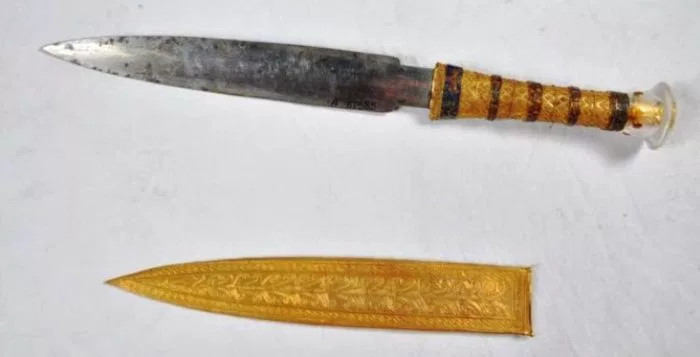King Tut's golden dagger was made from meteorite
New research by international scientists shows King Tutankhamun is buried with a meteorite-originated dagger in the universe.
Using a non-damaging fluorescent X-ray spectrometer, a group of Italian and Egyptian researchers confirmed that the iron blade of the dagger placed next to the thigh had King Tut's mummy originated from meteorite, Live. Science reported. The team of researchers, including researchers from Milan Polytechnic University, the University of Pisa and the Egyptian Museum in Cairo, detailed the findings in the journal Meteoritics and Planetary Science in late May.
The dagger is in the gallery of the Egyptian Museum. According to the description of Howard Carter, who discovered the tomb filled with King Tutankhamun's treasures in 1922, this is a finely carved gold dagger and crystal decoration.
Manufactured from a homogeneous metal material, the blade has a gold cast part. In particular, the knife shell is also made of gold, complete with floral motifs on one side and the feathers on the other side with the head of a jackal on the edge of the knife.

The dagger was buried with King Tutankhamun in the coffin.(Photo: Daniela Comelli).
Technological improvements allow researchers to identify blade components." The high nickel ratio indicates iron metal originated from meteorites, " Discovery News quoted Daniela Comelli, a scientist at the Department of Physics at Milan Polytechnic, the lead author of the study.
Iron meteorites mainly consist of iron and nickel , with small amounts of cobalt, phosphorus, sulfur and carbon. While artifacts produced from iron ore contain up to 4% nickel, iron blades on King Tutankhamun's dagger contain nearly 11% nickel . Other evidence helps confirm the origin of the blade's meteorite from the cobalt trace.
"The proportion of nickel and cobalt in the blade is consistent with the rate in iron meteorites, similar to the original rate in the period of formation of planets of the early solar system , " Comelli said. Comelli's group also learned about the origin of the iron blade.
"We consider all meteors found in the area within a radius of 2,000km from the Red Sea and find 20 iron meteorites , " Comelli said. "Only a meteor named Kharga has nickel and cobalt components corresponding to the blade composition."
A Kharga meteorite fragment was found in 2000 in the limestone plateau at Mersa Matruh, the seaport 240km west of Alexandria, Egypt. Research shows that the ancient Egyptians attach great importance to iron taken from meteorites and use them to produce precious objects . Possibly, the ancient Egyptians conceived the pieces of iron falling from the sky carrying the message of the gods.
The high quality of the dagger blade buried next to King Tut indicated that the iron forging profession was developed in the 14th century BC. The dagger is not the only object of cosmic origin in the tomb of the young king. The king's necklace is pierced by a beetle-shaped talisman, made from silicon glass in the Libyan desert.
This type of glass was created by the impact of meteors or comets on sand. Natural glass exists only in the remote and remote western desert regions of Egypt. To produce an amulet, ancient Egyptians had to cross desert roads longer than 800km.
- The reason King Tut invented a gold-studded dagger with meteors
- 4,000-year-old dagger knife attaches more than 140,000 gold beads
- Discovered 5,000-year-old gold dagger
- Suddenly found a 4000-year-old dagger in Slovakia
- The meteorite is extremely 'terrifying', more sparkling than pure gold
- Traces of the king's golden throne defeated Troy
- Egypt made a false tomb for King Tut
- King Richard III will be buried
- Europe set up a meteorite monitoring center
- 10 premium dishes can burn your bag
- Russian imminent imminent perfume perfume
- Hopeless attempt to find treasure 500 tons of gold by King Solomon
 Discovered an ancient centipede fossil 99 million years old
Discovered an ancient centipede fossil 99 million years old Discovered bat-like dinosaurs in China
Discovered bat-like dinosaurs in China Discovered a 200-year-old bronze cannon of the coast
Discovered a 200-year-old bronze cannon of the coast Discover 305 million-year-old spider fossils
Discover 305 million-year-old spider fossils